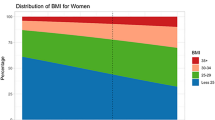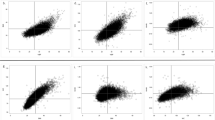Abstract
Clinically severe or morbid obesity (body mass index (BMI) >40 or 50 kg m−2) entails far more serious health consequences than moderate obesity for patients, and creates additional challenges for providers. The paper provides time trends for extreme weight categories (BMI >40 and >50 kg m−2) until 2010, using data from the Behavioral Risk Factor Surveillance System. Between 2000 and 2010, the prevalence of a BMI >40 kg m−2 (type III obesity), calculated from self-reported height and weight, increased by 70%, whereas the prevalence of BMI >50 kg m−2 increased even faster. Although the BMI rates at every point in time are higher among Hispanics and Blacks, there were no significant differences in trends between them and non-Hispanic Whites. The growth rate appears to have slowed down since 2005. Adjusting for self-report biases, we estimate that in 2010 15.5 million adult Americans or 6.6% of the population had an actual BMI >40 kg m−2. The prevalence of clinically severe obesity continues to be increasing, although less rapidly in more recent years than prior to 2005.
This is a preview of subscription content, access via your institution
Access options
Subscribe to this journal
Receive 12 print issues and online access
$259.00 per year
only $21.58 per issue
Buy this article
- Purchase on Springer Link
- Instant access to full article PDF
Prices may be subject to local taxes which are calculated during checkout

Similar content being viewed by others
References
Finucane MM, Stevens GA, Cowan MJ, Danaei G, Lin JK, Paciorek CJ et al. National, regional, and global trends in body-mass index since 1980: systematic analysis of health examination surveys and epidemiological studies with 960 country-years and 9.1 million participants. Lancet 2011; 377: 557–567.
Flegal KM, Carroll MD, Kit BK, Ogden CL . Prevalence of obesity and trends in the distribution of body mass index among US adults, 1999–2010. JAMA 2012; 307: 491–497.
Centers for Disease Control and Prevention (CDC). Vital signs: state-specific obesity prevalence among adult—United States, 2009. MMWR Morb Mortal Wkly Rep 2010; 59: 951–955.
Yanovski SZ, Yanovski JA . Obesity prevalence in the United States--up, down, or sideways? N Engl J Med 2011; 364: 987–989.
Sturm R . Increases in clinically severe obesity in the US: 1986–2000. Arch Intern Med 2003; 163: 2146–2148.
Galinsky T, Hudock S, Streit J . Addressing the need for research on bariatric patient. Rehabil Nurs 2010; 35: 242–247.
Sturm R, Bao Y . Socioeconomics of obesity. In: Kushner RF, Bessesen DH, (eds). Treatment of the Obese Patient. Humana Press Inc: Totowa, NJ, 2007. pp 174–194.
Flegal KM, Carroll MD, Ogden CL, Johnson CL . Prevalence and trends in obesity among US adults, 1999–2000. JAMA 2002; 288: 1723–1727.
Basterra-Gortari FJ, Beunza JJ, Bes-Rastrollo M, Toledo E, García-López M, Martínez-González MA . Increasing trend in the prevalence of morbid obesity in Spain: from 1.8 to 6.1 per thousand in 14 years. Rev Esp Cardiol 2011; 64: 424–426.
Andreyeva T, Sturm R, Ringel JS . Moderate and severe obesity have large differences in health care costs. Obes Res 2004; 12: 1936–1943.
Centers for Disease Control, Behavioral Risk Factor Surveillance Survey homepage at http://www.cdc.gov/brfss/ (accessed 22 March 2012).
Gorber SC, Tremblay M, Moher D, Gorber B . A comparison of direct vs. self-report measures for assessing height, weight and body mass index: a systematic review. Obes Rev 2007; 8: 307–326.
Gorber SC, Tremblay MS . The bias in self-reported obesity from 1976 to 2005: a Canada-US comparison. Obesity 2010; 18: 354–361.
Acknowledgements
This project was supported by grant number R01HD057193 from NICHD (RS) and T32 HS000046 from the Agency for Healthcare Research and Quality (AH). The content is solely the responsibility of the authors and does not necessarily represent the official views of NIH or the Agency for Healthcare Research and Quality.
Author information
Authors and Affiliations
Corresponding author
Ethics declarations
Competing interests
The authors declare no conflict of interest.
Rights and permissions
About this article
Cite this article
Sturm, R., Hattori, A. Morbid obesity rates continue to rise rapidly in the United States. Int J Obes 37, 889–891 (2013). https://doi.org/10.1038/ijo.2012.159
Received:
Revised:
Accepted:
Published:
Issue Date:
DOI: https://doi.org/10.1038/ijo.2012.159
Keywords
This article is cited by
-
The impact of severe obesity on image quality and ventricular function assessment in echocardiography and cardiac MRI
The International Journal of Cardiovascular Imaging (2024)
-
On the relationship between childhood socioeconomic status and eating preference: influence from attentional bias and decision-making style
Current Psychology (2024)
-
Banded One-Anastomosis Gastric Bypass (BOAGB) for Patients Living with Obesity and Extreme Obesity: A Single Institution’s Experience
Obesity Surgery (2024)
-
Severe Cannabis use is Associated with Complications and Prolonged Length of Stay in Bariatric Surgery
Obesity Surgery (2023)
-
Profiling the injuries of law enforcement recruits during academy training: a retrospective cohort study
BMC Sports Science, Medicine and Rehabilitation (2022)



